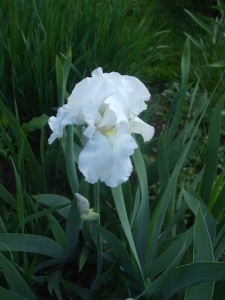
‘Primal Scream’ daylily has 7 ½- to 8 ½-inch wide tangerine blooms in late summer and gets about 34 inches tall. Photo courtesy perennialrescource.com
Daylilies and irises are commonplace in most Hoosier gardens, but gardeners still have questions about these mainstay perennials.
For instance, a lot of gardeners confuse daylilies (Hemerocallis) with true lilies (Lilium), but they are two different species. A lily grows from a bulb and a daylily grows from an underground stem, called a rhizome. Most Iris also grows from a rhizome, which people sometimes call a bulb.
There are early, mid and late season blooming daylilies and irises and those that rebloom. Daylilies and irises do best in full sun, but will tolerate light shade.
Originating in Asia, there are more than 65,000 varieties of daylilies with thousands of colors and variations. There are about 300 species of irises, from the native crested iris to bearded and Siberian types.
“Daylilies thrive on water throughout the season. Irises really don’t need too much water after they bloom,” said John Everitt, president of the Indiana Daylily and Iris Society.
Keep daylily and iris tidy by removing spent flowers and the stems when done blooming. Cut dayliles back to the ground in fall, which is also a good time to divide them. Most irises, too, can be divided and transplanted then. Bearded iris should be cut back in late summer or early fall to reduce infestation from the iris borer, which lays its eggs on the leaves.

Fragrant ‘Feed Back’ bearded iris gets about 3 feet tall when it blooms in late spring to early summer and again in late summer. Photo courtesy perennialresource.com
A common practice Everitt would like to see changed is planting daylilies and irises in separate beds. “A whole bed of the sword-leafed iris or a large expanse of grassy daylily foliage can be a bit monotonous,” he said. He recommends planting daylilies and irises among other perennials with similar horticulture requirements to provide different bloom shapes and textures.
Good companions for daylilies include: bee balm (Monarda fistulosa, M. didyma), Shasta daily (Leucanthemum superba), garden phlox (P. paniculata), coneflowers (Echinacea purpurea) and black-eyed Susan (Rudbeckia hirta), Everitt said.
For bearded iris companions, Everitt recommends: peony (Paeonia), salvia (S. nemerosa, S. sylvestris), beardtongue (Penstemon digitalis) and catmint (Nepeta faasenii, N. racemosa).
To talk first hand about these beautiful plants, visit the Indiana Daylily and Iris Society’s annual sale, 10 a.m. to 4 p.m., Saturday, Aug. 16, 2014 at Sullivan Hardware and Garden, 6955 N. Keystone Ave. “Our sales typically offer 20 to 25 different iris cultivars and up to 50 different daylily cultivars,” Everitt said.